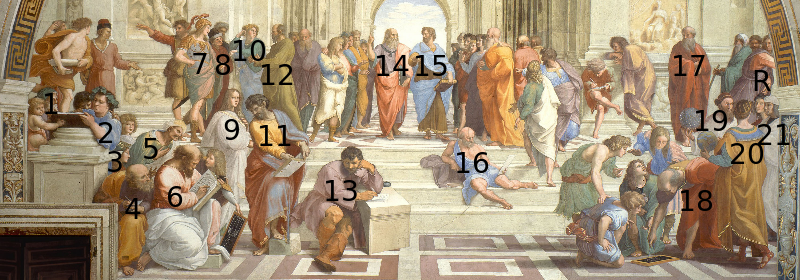The School of Athens

The School of Athens is a famous fresco by the artist Raphael. It was painted during the Italian Renaissance between 1510 and 1511. The picture is known as "Raphael's masterpiece and the perfect embodiment of the classical spirit of the High Renaissance".
It was painted as a part of Raphael's commission to decorate with frescoes the rooms now known as the Stanze di Raffaello, in the Apostolic Palace in the Vatican.
Figures
[change | change source]Only the identities of some of the philosophers in the picture, such as Plato or Aristotle, are certain.
A proposed list of possible identifications, is the following:[1]

1: Zeno of Citium 2: Epicurus Possibly, the image of two philosophers, who were typically shown in pairs during the Renaissance: Heraclitus, the "weeping" philosopher, and Democritus, the "laughing" philosopher. 3: unknown (believed to be Raphael)[2] 4: Boethius or Anaximander or Empedocles? 5: Averroes 6: Pythagoras 7: Alcibiades or Alexander the Great? 8: Antisthenes or Xenophon or Timon? 9: Raphael,[2][3][4] Fornarina as a personification of Love[5] or Francesco Maria della Rovere? 10: Aeschines or Xenophon? 11: Parmenides? (Leonardo da Vinci) 12: Socrates 13: Heraclitus (Michelangelo) 14: Plato (Leonardo da Vinci) 15: Aristotle (Giuliano da Sangallo) 16: Diogenes of Sinope 17: Plotinus (Donatello?) 18: Euclid or Archimedes with students (Bramante?) 19: Strabo or Zoroaster? (Baldassare Castiglione) 20: Ptolemy? R: Apelles (Raphael) 21: Protogenes (Il Sodoma, Perugino, or Timoteo Viti)[6]
Other websites
[change | change source]![]() Media related to The School of Athens at Wikimedia Commons
Media related to The School of Athens at Wikimedia Commons
References
[change | change source]- ↑ Following The School of Athens, "Who is Who?" by Michael Lahanas
- ↑ 2.0 2.1 Raphael has reused the motif of two women from his earlier work the Vision of a Knight. Raphaël, page 215, Edition 31; Edition 42 of Chefs-d'oeuvre de l'art: Grands peintres, Taylor & Francis, 1966. or (Federico II of Mantua?)
- ↑ Understanding art concise history page 118
- ↑ The interpretation of this figure as Hypatia seems to have originated from the Internet. Serious sources don't mention it at all. H. J. Mozans (=John Augustine Zahm) specifically regrets that Hypatia doesn't appear in the painting in his book Women in Science p.141
- ↑ Raphael's lover Fornarina is portrayed in a famous painting in the National Gallery of Ancient Art in Rome. This identification has been introduced on 2002 by Matteo Smolizza during his cooperation with Lorenza Mochi Onori, former Director of the Museum, in the occasion of the Exhibit La Fornarina di Raffaello, Milan, Fondazione Arte e Civiltà, March 14 - June 2, 2002. It was later investigated on the basis of 1) position of the portrait (specular to Raphael's one) ; 2) appearance compared with contemporary Raphael’s drawings; 3) strictly contemporary texts by Raphael to the woman; 4) fresco's general meaning. Cfr. Smolizza, pp. 68-74
- ↑ The interpretation of this figure as Sodoma may be in error, as Sodoma was 33 at the time of painting, while Raphael's teacher, Perugino, was a renowned painter and aged about 60 at the time of this painting, consistent with the image. Timoteo Viti is another plausible candidate.
